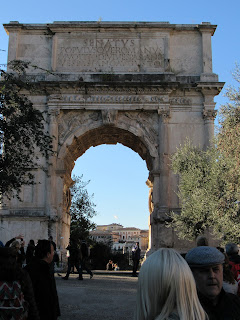Spotlight: The Roman Forum was the heart of Ancient Rome. It started as a marketplace, but developed into the political, commercial and social center of Roman life. Known as the Forum Magnum, it was the site of triumphal processions, elections, a venue for public speeches, criminal trials, and even gladiator battles.
Located in the small valley between the Capitoline and Palatine Hills, the land on which the Forum was built used to be a marshy lake containing water runoff from Rome's seven hills. The lake was drained in ancient times and became a central marketplace for its inhabitants. The Forum's earliest shrines and temples were built along the southeastern edge including the Temple of Saturn, the Regia (the first royal palace), the Temple of Vesta, and the complex of the Vestal Virgins. These were all rebuilt after the rise of Imperial Rome. The northwestern ridge included shrines such as the Umbilicus Urbis and the Shrine of Vulcan. This area eventually developed into the political center of the Forum as new buildings were added piecemeal over the centuries, including the Senate House, government buildings, and tribunals. The sides of the Forum were defined by two large basilicas - the Basilica Aemilia on the north and the Basilica Julia on the south. As Rome grew, adjacent Forums were added to meet the needs of the growing population. The last major addition to the old Forum was the Basilica of Maxentius, built during the reign of Constantine in 312 AD.
 |
| Capitoline Hill |
 |
| Palatine Hill |
 |
| Via Sacra |
 |
| Triumphal Arch |
 |
| Julius Caesar's "sepulcher" |
 |
| Caesar's funeral pyre |
Location: The Roman Forum is located along the Via Sacra, and was the heart of city during the days of the Roman Empire. The closest major road is the Via dei Fori Imperiali
Cost: Tickets cost 12 euros from the official site and includes admission to the Colosseum, Palatine, and current exhibitions. Tours from private vendors cost anywhere from $40 - several hundred dollars for VIP service. The cost is 7.50 euros for citizens of the European Union, and free to children under age 18.
Time: The Forum is open from 8:30 am until about 1 hour before sunset. You could spend anywhere from 1-4 hours exploring the ruins depending on your level of interest.
Description: Although interest in the old Forum was sparked during the Renaissance, excavation efforts didn't begin until the 18th century. It wasn't until the 20th century that those excavations blossomed into a large scale effort. Today, the Forum is a sprawl of ruins that are being painstakingly excavated by archaeologists in an attempt to uncover the physical remnants of Rome's glorious past.
One of the most important excavations is the Complex of the Vestal Virgins. The residence of these honored citizens, the Atrium Vestae, was a three-story 50 room palace located behind the Temple of Vesta. It was rebuilt several times over the course of empire, and was even used for a time as the papal court after the order was disbanded following the compulsory conversion to Christianity. Today, remains of the statues of the Vestals can be seen in the Atrium Vestae.
 |
| Temple of Vesta |
 |
| Atrium Vestae |
 |
| statues of the Vestals |
 |
| Temple of Romulus |
 |
| Mamertine Prison |
 |
| Antoninus and Faustina Temple |
Things You Should Know: - The excavation process is ongoing. Each year a new area is designated for excavation, uncovering new wonders from Rome's epic past.
- Your official ticket to the Forum, Colosseum and Palatine Hill is good for 2 days.
- If you visit the Forum without a guide, a detailed guide book, or an audio tour, you probably won't have any idea what you are looking at besides a bunch of ruins. I strongly recommend doing some research ahead of time and picking a tour that fits your budget and time schedule. The following website has a variety of tours with different prices and times to give you an idea of what's out there.
- The Forum covers a large area with very little shade. Make sure you wear comfortable walking shoes and bring plenty of water.
- The ticket booth near the Colosseum has the longest lines. If you purchase your ticket at Palatine Hill, the lines are much shorter. Or you can order them online from the official web site, but there is a processing fee.
Nearby: The Colosseum, Campidoglio, The Altar of the Fatherland, Capitoline Museums, Marcello Theater
No comments:
Post a Comment